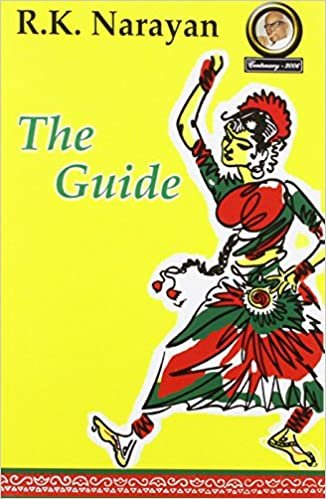The Guide

Rating: 4.4/5
Author: R.K. Narayan
Paperback: 217 pages
Publisher: Methuen Publishing (UK), Viking Press (US)
Publication Date: 1958
Language: English
Genre: Fiction
ISBN-10: 9788185986074
ISBN-13: 978-8185986074
ASIN: 818598607X
Plot:
More by chance than skill, he seduces her away from her husband, a lonely writer who is obsessed with local rock-carvings, and transforms her into a celebrity courted by wealthy and influential dignitaries wherever she performs. Raju makes a loses a fortune, finds himself in jail, and through a series of hilarious, ironic circumstances becomes one of India's great holy men.
The history of his success and unexpected fame has all the excitement of a suspense story, told with Narayan's customary tolerance and delightful humour. At the same time it raises many profound and disturbing questions.
Review:
The character ‘Raju’ is a hypocritical character from the very beginning of his life. As a tour guide, he misguides the tourists willingly. He also has no sense of right or wrong in his dealing with situations in his life.
The other themes of ‘materialism’, ‘dishonesty’ are also portrayed majorly by the character Raju. He misleads Rosie into falling in love with him by telling her all the things she wanted to hear, all for his own interest. He gets a two-year prison sentence for forgery. He tricks people to extract money out of them and that is all that matters to him. For him, money means more than people. Finally his actions lead him to a place where money is no longer attainable.
Narayan introduces the concept of ‘Karma’, he treats the character of ‘Raju’ with the consequences of his obnoxious, self-indulgent, greedy, irresponsible, dishonest nature. He shows how Raju's greed leads him to lose Rosie, his money, and his influence and land in jail.
There has been a constant convergence of the Past and the Present. The character Rosie’s acceptance of her sexuality and her idea of independence all refer to the present ideologies while the character ‘Marco’ and his regressive and oppressive thoughts are of the past. Critic John Thieme writes- about the character of ‘Marco’ that - Marco is "resistant to any suggestion that the classical and the contemporary may be related" even when he sees the dancing motif on the cave walls.
At last, the journey of the dramatic transformation of the ‘crook guide’ to the ‘spiritual guide’. When the doctors and the government go all out to save him, Raju goes out to perform his daily routine of climbing down the steps to the river with the help of two men on both sides. He stands in the knee deep water and faces the mountain muttering his prayer while Velan and the other man continues to hold him and he says, “Velan, it’s raining in the hills. I can feel it coming up under my feet, up my legs,“ and he sags down. The way Raju’s life and his conscience turns around- has kept all the readers interested in his life all throughout.
Adaptations:
- The film Guide was released in 1965, based on the novel. It was directed by Vijay Anand. It starred Dev Anand as Raju, Waheeda Rehman as Rosie, Kishore Sahu (cameo), and Leela Chitnis in the lead roles.
- The novel was also adapted into a play in 1968.
About the Author:
R. K. Narayan was born in Madras, South India, and educated there and at Maharaja’s College in Mysore. His first novel Swami and Friends (1935) and its successor The Bachelor of Arts (1937) are both set in the enchanting fictional territory of Malgudi. Other ‘Malgudi’ novels are The Dark Room (1938), The English Teacher (1945), Mr. Sampath (1949), The Financial Expert (1952), The Man Eater of Malgudi (1961), The Vendor of Sweets (1967), The Painter of Signs (1977), A Tiger for Malgudi (1983), and Talkative Man (1986). His novel The Guide (1958) won him the National Prize of the Indian Literary Academy, his country’s highest literary honour. He was awarded in 1980 the A.C. Benson Medal by the Royal Society of Literature and in 1981 he was made an Honorary Member of the American Academy and Institute of Arts and Letters. As well as five collections of short stories, A Horse and Two Goats, An Astrologer’s Day and Other Stories, Lawley Road, Under the Banyan Tree and Malgudi Days, he has published a travel book, The Emerald Route, three collections of essays, A Writer’s Nightmare, Next Sunday and Reluctant Guru, three books on the Indian epics, and a volume of memoirs, My Days.















































